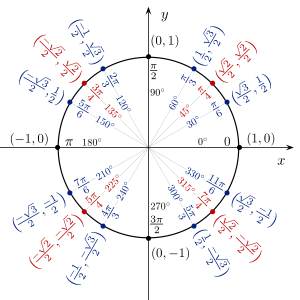In mathematics, the trigonometric functions (also called circular functions, angle functions or goniometric functions[1][2]) are real functions which relate an angle of a right-angled triangle to ratios of two side lengths. They are widely used in all sciences that are related to geometry, such as navigation, solid mechanics, celestial mechanics, geodesy, and many others. They are among the simplest periodic functions, and as such are also widely used for studying periodic phenomena through Fourier analysis.
The trigonometric functions most widely used in modern mathematics are the sine, the cosine, and the tangent. Their reciprocals are respectively the cosecant, the secant, and the cotangent, which are less used. Each of these six trigonometric functions has a corresponding inverse function, and an analog among the hyperbolic functions.[3]
The oldest definitions of trigonometric functions, related to right-angle triangles, define them only for acute angles. To extend these definitions to functions whose domain is the whole projectively extended real line, geometrical definitions using the standard unit circle (i.e., a circle with radius 1 unit) are often used. Modern definitions express trigonometric functions as infinite series or as solutions of differential equations. This allows extending the domain of sine and cosine functions to the whole complex plane, and the domain of the other trigonometric functions to the complex plane from which some isolated points are removed.
Right-angled triangle definitions
In this section, an upper-case letter denotes a vertex of a triangle and the measure of the corresponding angle; The lower-case form of the same letter denotes the opposite side of the triangle and its length. In the definitions that follow, θ corresponds to A in the diagram.
If the angle θ is given, then all sides of the right-angled triangle are well-defined up to a scaling factor. This means that the ratio of any two side lengths depends only on θ. Thus these six ratios define six functions of θ, which are the trigonometric functions. More precisely, the six trigonometric functions are:
- sine

|
- cosecant

|
- cosine

|
- secant

|
- tangent

|
- cotangent

|
In a right-angled triangle, the sum of the two acute angles is a right angle, that is, 90° or Template:Sfrac radians.
Summary of relationships between trigonometric functions[1]
| Function
|
Abbreviation
|
Description
|
Relationship
|
| using radians
|
using degrees
|
| sine
|
sin
|
Template:Sfrac
|

|

|
| cosine
|
cos
|
Template:Sfrac
|

|

|
| tangent
|
tan (or tg)
|
Template:Sfrac
|

|

|
| cotangent
|
cot (or cotan or cotg or ctg or ctn)
|
Template:Sfrac
|

|

|
| secant
|
sec
|
Template:Sfrac
|

|

|
| cosecant
|
csc (or cosec)
|
Template:Sfrac
|

|

|

The unit circle, with some points labeled with their cosine and sine (in this order), and the corresponding angles in radians and degrees.



















